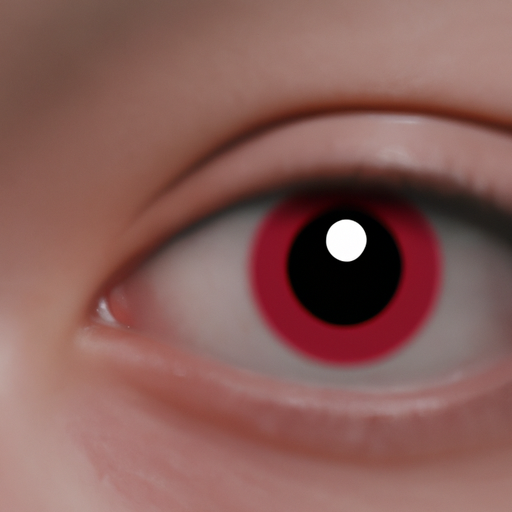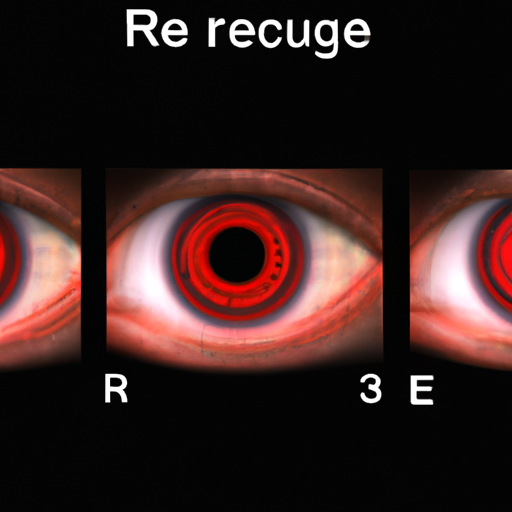-
Table of Contents
Redness around the eye can be a common symptom that may indicate various underlying causes. It is important to identify the cause in order to determine the appropriate treatment. In this introduction, we will briefly discuss six potential causes of redness around the eye.
Allergies and Redness Around the Eyes
Allergies and Redness Around the Eyes
Redness around the eyes can be a common symptom of allergies. Allergies occur when the immune system overreacts to a substance that is normally harmless, such as pollen, pet dander, or dust mites. When these allergens come into contact with the eyes, they can cause irritation, itching, and redness.
One of the most common causes of redness around the eyes is allergic conjunctivitis. This condition occurs when the conjunctiva, the thin membrane that covers the white part of the eye and the inside of the eyelids, becomes inflamed due to an allergic reaction. The eyes may become red, itchy, and watery, and there may be a discharge or crusting around the eyelashes.
Another cause of redness around the eyes is hay fever, also known as allergic rhinitis. Hay fever is a seasonal allergy that is triggered by pollen from trees, grasses, and weeds. When pollen comes into contact with the eyes, it can cause redness, itching, and watering. Other symptoms of hay fever may include sneezing, a runny or stuffy nose, and itching in the throat or ears.
Contact dermatitis is another common cause of redness around the eyes. This condition occurs when the skin comes into contact with an irritant or allergen, such as certain cosmetics, soaps, or metals. The skin around the eyes may become red, swollen, and itchy, and there may be a rash or blisters. It is important to identify and avoid the trigger to prevent further irritation.
In some cases, redness around the eyes may be caused by an allergic reaction to certain medications or eye drops. This is known as drug-induced allergic conjunctivitis. The eyes may become red, itchy, and swollen, and there may be a discharge or crusting. If you suspect that a medication or eye drop is causing your symptoms, it is important to consult with a healthcare professional.
In addition to allergies, redness around the eyes can also be caused by other factors. Dry eye syndrome, for example, occurs when the eyes do not produce enough tears or when the tears evaporate too quickly. This can lead to redness, itching, and a gritty sensation in the eyes. Environmental factors, such as exposure to smoke, wind, or air pollution, can also cause redness and irritation.
If you are experiencing redness around the eyes, it is important to consult with a healthcare professional for an accurate diagnosis and appropriate treatment. They may recommend over-the-counter or prescription eye drops to relieve symptoms and reduce inflammation. In some cases, they may also recommend avoiding certain allergens or irritants, using cold compresses, or practicing good eye hygiene.
In conclusion, redness around the eyes can be caused by allergies, such as allergic conjunctivitis or hay fever. It can also be caused by contact dermatitis, drug-induced allergic conjunctivitis, dry eye syndrome, or environmental factors. If you are experiencing redness around the eyes, it is important to seek medical advice for proper diagnosis and treatment.
Conjunctivitis and Redness Around the Eyes
Conjunctivitis, commonly known as pink eye, is a condition that causes redness and inflammation around the eyes. It is a highly contagious infection that can be caused by various factors. In this article, we will explore six common causes of redness around the eyes, with a focus on conjunctivitis.
One of the most common causes of redness around the eyes is viral conjunctivitis. This type of conjunctivitis is caused by a virus and is highly contagious. It is often accompanied by other symptoms such as itching, watering, and a gritty sensation in the eyes. Viral conjunctivitis usually resolves on its own within a week or two, but it is important to practice good hygiene to prevent spreading the infection to others.
Bacterial conjunctivitis is another common cause of redness around the eyes. This type of conjunctivitis is caused by bacteria and can be quite severe. It is characterized by a thick, yellow or green discharge from the eyes, along with redness and swelling. Bacterial conjunctivitis is usually treated with antibiotic eye drops or ointments to help clear the infection.
Allergic conjunctivitis is a type of eye allergy that can cause redness and itching around the eyes. It is often triggered by allergens such as pollen, dust mites, or pet dander. Allergic conjunctivitis can be seasonal or perennial, depending on the allergen. It is important to identify and avoid the allergen to prevent symptoms. Over-the-counter antihistamine eye drops can also provide relief from redness and itching.
Dry eyes can also cause redness around the eyes. When the eyes do not produce enough tears or the tears evaporate too quickly, the eyes can become dry and irritated. This can lead to redness, itching, and a burning sensation. Using artificial tears or lubricating eye drops can help alleviate the symptoms of dry eyes and reduce redness.
Contact lens wearers may experience redness around the eyes due to contact lens-related issues. Improper lens care, wearing lenses for too long, or using expired lenses can lead to eye irritation and redness. It is important to follow proper hygiene practices when wearing contact lenses and to replace them as recommended by your eye care professional.
Finally, eye strain can also cause redness around the eyes. Spending long hours in front of a computer screen or reading for extended periods can strain the eyes and lead to redness and fatigue. Taking regular breaks, practicing the 20-20-20 rule (looking at something 20 feet away for 20 seconds every 20 minutes), and ensuring proper lighting can help reduce eye strain and alleviate redness.
In conclusion, redness around the eyes can be caused by various factors, with conjunctivitis being a common culprit. Viral and bacterial conjunctivitis are highly contagious infections that require proper hygiene and sometimes medication for treatment. Allergic conjunctivitis is an eye allergy triggered by allergens, while dry eyes can result from insufficient tear production. Contact lens-related issues and eye strain can also cause redness around the eyes. If you experience persistent redness or other concerning symptoms, it is important to consult with an eye care professional for proper diagnosis and treatment.
Dry Eye Syndrome and Redness Around the Eyes

Dry Eye Syndrome and Redness Around the Eyes
Redness around the eyes can be a common occurrence for many individuals. It can be caused by a variety of factors, ranging from allergies to infections. One of the most common causes of redness around the eyes is dry eye syndrome. Dry eye syndrome occurs when the eyes do not produce enough tears or when the tears evaporate too quickly.
Dry eye syndrome can be caused by a number of factors, including age, certain medications, and medical conditions such as diabetes or rheumatoid arthritis. When the eyes do not produce enough tears, they can become dry and irritated, leading to redness and discomfort. In addition to redness, individuals with dry eye syndrome may also experience a gritty or sandy feeling in their eyes, as well as blurred vision.
Another cause of redness around the eyes is allergies. Allergies occur when the immune system overreacts to a substance that is normally harmless, such as pollen or pet dander. When the eyes come into contact with an allergen, they can become red, itchy, and watery. Allergic reactions can also cause swelling around the eyes, making them appear puffy and irritated.
Infections can also lead to redness around the eyes. Bacterial or viral infections can cause the eyes to become red and swollen. Conjunctivitis, also known as pink eye, is a common infection that can cause redness and irritation. Pink eye can be highly contagious and is often spread through direct contact with an infected individual or by touching contaminated surfaces.
In addition to dry eye syndrome, allergies, and infections, other causes of redness around the eyes include environmental factors, such as exposure to smoke or chemicals. Smoke can irritate the eyes and cause them to become red and watery. Chemicals, such as those found in certain cosmetics or cleaning products, can also cause redness and irritation.
Certain lifestyle habits can also contribute to redness around the eyes. Rubbing the eyes excessively can cause them to become red and irritated. This can be a common habit for individuals with allergies or dry eye syndrome, as they may be trying to relieve itching or discomfort. However, rubbing the eyes can actually worsen the redness and irritation.
In conclusion, redness around the eyes can be caused by a variety of factors. Dry eye syndrome, allergies, infections, environmental factors, and lifestyle habits can all contribute to redness and irritation. It is important to identify the underlying cause of redness around the eyes in order to determine the appropriate treatment. If you are experiencing persistent redness or discomfort, it is recommended to consult with an eye care professional for a proper diagnosis and treatment plan.
Eye Infections and Redness Around the Eyes
Redness around the eyes can be a common occurrence and is often a result of various factors. One of the main causes of redness around the eyes is eye infections. Eye infections can be caused by bacteria, viruses, or fungi, and can lead to redness, itching, and discomfort.
One common type of eye infection that can cause redness around the eyes is conjunctivitis, also known as pink eye. Conjunctivitis is an inflammation of the conjunctiva, the thin membrane that covers the white part of the eye and the inner surface of the eyelids. It can be caused by a viral or bacterial infection, and can spread easily from person to person. Redness, itching, and a discharge from the eyes are common symptoms of conjunctivitis.
Another type of eye infection that can cause redness around the eyes is blepharitis. Blepharitis is an inflammation of the eyelids, usually caused by bacteria or a skin condition such as rosacea or seborrheic dermatitis. It can cause redness, swelling, and crusting of the eyelids, as well as a gritty or burning sensation in the eyes. If left untreated, blepharitis can lead to more serious complications, such as styes or chalazia.
In addition to eye infections, allergies can also cause redness around the eyes. Allergic conjunctivitis is a common condition that occurs when the eyes come into contact with an allergen, such as pollen, pet dander, or dust mites. Redness, itching, and watering of the eyes are typical symptoms of allergic conjunctivitis. Avoiding allergens and using over-the-counter antihistamine eye drops can help alleviate the redness and discomfort.
Dry eyes can also contribute to redness around the eyes. When the eyes do not produce enough tears or the tears evaporate too quickly, the eyes can become dry and irritated. This can lead to redness, itching, and a gritty sensation in the eyes. Dry eyes can be caused by various factors, including aging, certain medications, and environmental conditions such as dry air or wind. Using artificial tears or lubricating eye drops can help relieve the redness and discomfort associated with dry eyes.
In some cases, redness around the eyes may be a symptom of a more serious underlying condition. For example, uveitis is an inflammation of the uvea, the middle layer of the eye. It can cause redness, pain, and blurred vision, and may be associated with other systemic conditions such as autoimmune diseases or infections. If you experience persistent redness around the eyes, it is important to consult with an eye care professional to determine the underlying cause and receive appropriate treatment.
In conclusion, redness around the eyes can be caused by various factors, including eye infections, allergies, dry eyes, and underlying medical conditions. It is important to identify the cause of the redness in order to receive appropriate treatment. If you experience persistent redness or other symptoms, it is recommended to consult with an eye care professional for a proper diagnosis and management plan.
Eye Strain and Redness Around the Eyes
Eye Strain and Redness Around the Eyes
Eye strain is a common condition that affects many people, causing discomfort and redness around the eyes. It occurs when the eyes are overworked or fatigued, often due to prolonged use of digital devices or reading for extended periods. In this article, we will explore six common causes of redness around the eyes that are related to eye strain.
One of the primary causes of eye strain and subsequent redness is excessive screen time. With the rise of technology, many individuals spend hours each day staring at computer screens, smartphones, or tablets. This constant exposure to digital devices can lead to eye strain, resulting in redness and irritation. To alleviate this issue, it is recommended to take regular breaks and practice the 20-20-20 rule, which involves looking away from the screen every 20 minutes and focusing on an object 20 feet away for 20 seconds.
Another cause of redness around the eyes is inadequate lighting. When the lighting in a room is too dim or too bright, it can strain the eyes and cause discomfort. Insufficient lighting forces the eyes to work harder to focus, leading to redness and fatigue. On the other hand, excessive brightness can cause glare, which also contributes to eye strain. To prevent this, it is essential to ensure proper lighting in your workspace or living area, using a combination of natural and artificial light sources.
Dry eyes are a common condition that can cause redness and irritation. When the eyes do not produce enough tears or the tears evaporate too quickly, the result is dryness and discomfort. This can be exacerbated by factors such as air conditioning, heating, or windy environments. To alleviate dry eyes, it is recommended to use artificial tears or lubricating eye drops to keep the eyes moist. Additionally, using a humidifier in dry environments can help maintain adequate moisture levels.
Allergies are another common cause of redness around the eyes. When the eyes come into contact with allergens such as pollen, dust mites, or pet dander, they can become irritated and red. This is often accompanied by itching, watering, and swelling. To manage allergies, it is important to identify and avoid triggers whenever possible. Over-the-counter antihistamine eye drops can also provide relief from redness and other allergy symptoms.
Lack of sleep can contribute to eye strain and redness. When we do not get enough rest, our eyes can become tired and bloodshot. This is because sleep deprivation affects the body’s ability to repair and rejuvenate itself, including the eyes. To combat this, it is crucial to prioritize sleep and establish a consistent sleep schedule. Creating a relaxing bedtime routine and ensuring a comfortable sleep environment can also promote better sleep quality.
Lastly, poor eye hygiene can lead to redness and irritation. Failure to remove eye makeup properly or wearing contact lenses for extended periods can cause debris and bacteria to accumulate, leading to redness and discomfort. It is important to follow proper hygiene practices, such as removing makeup before bed and cleaning contact lenses as instructed. Additionally, regularly replacing contact lenses and avoiding sharing eye makeup can help prevent eye strain and redness.
In conclusion, eye strain is a common condition that can cause redness and discomfort around the eyes. Excessive screen time, inadequate lighting, dry eyes, allergies, lack of sleep, and poor eye hygiene are all factors that contribute to this issue. By implementing strategies to reduce eye strain and practicing good eye hygiene, individuals can alleviate redness and promote overall eye health.
Q&A
1. What are the common causes of redness around the eye?
Common causes of redness around the eye include allergies, conjunctivitis (pink eye), dry eye syndrome, eye strain, and eye infections.
2. Can lack of sleep cause redness around the eye?
Yes, lack of sleep can cause redness around the eye due to blood vessels becoming more visible and dilated.
3. Is eye makeup a possible cause of redness around the eye?
Yes, eye makeup can cause redness around the eye if it irritates the sensitive skin or if expired or contaminated products are used.
4. Can environmental factors like pollution cause redness around the eye?
Yes, exposure to environmental factors like pollution, smoke, or chemicals can irritate the eyes and lead to redness.
5. Are contact lenses a potential cause of redness around the eye?
Yes, wearing contact lenses for an extended period, improper lens care, or an allergic reaction to lens materials can cause redness and irritation around the eye.In conclusion, there are several potential causes for redness around the eye. These include allergies, conjunctivitis, dry eye syndrome, eye strain, blepharitis, and styes. It is important to consult with a healthcare professional for an accurate diagnosis and appropriate treatment.
Hi, I’m Pablo Garduno. I am a biohacking enthusiast, and Head Writer of SanDiegoHealth.org. I write the majority of the content on this site, and appreciate you taking the time to read my work.

